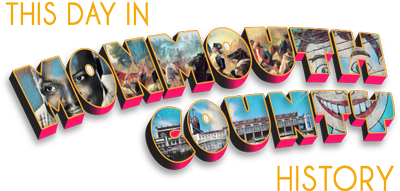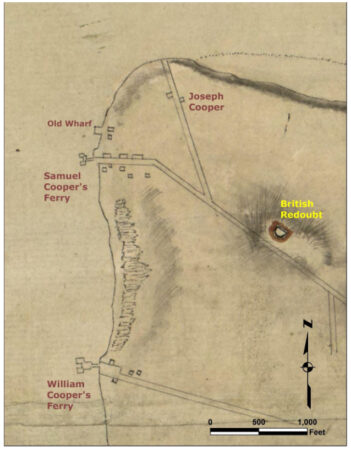On May 3, 1778, the British established a post at Cooper’s Ferry, near where Camden is today, to protect wood cutters. The British army in Philadelphia had been ordered to evacuate the city, to focus resources on their strongholds in New York City and the southern U.S. The Army would have to march through hostile New Jersey territory to reach New York, and expected to encounter armed militia, the Continental Army, or both, while en route. Thus began what will ultimately lead to the Battle of Monmouth, and what would be a critical test for George Washington, and his troops who had spent a harsh winter at Valley Forge, training and preparing to take on the British army.
On May 14, 1778, the British army prepared to evacuate Philadelphia by packing heavy baggage to be shipped to New York, either via ship, or overland, across the Delaware River and New Jersey, with the army. Some of that baggage passed through Monmouth County from one end to the other. It was the wealthy and well-connected few who had the luxury of having their belongings and loved ones relocated via the Royal Navy, which went relatively unchallenged on the open sea. For the rest, who would have to march with the soldiers, there was much concern about the safety of what would turn out to be a very long baggage and supply train in Patriot territory.
On May 29, 1778, British General Sir Henry Clinton deployed two regiments across the river at Cooper’s Ferry, near Camden, to reinforce the garrison there. New Jersey militia were watching and reporting all such movements to George Washington’s command center. At this point, neither the British nor the Americans know what route General Clinton would choose in order to reach New York City.
The British army spent two weeks establishing a post at Cooper’s Ferry. On June 1, 1778, the British began moving wagons and provisions across the river. Further upriver, George Washington was making similar preparations to move his army across the Delaware so as to engage the British.
On June 14, 1778, British General Sir Henry Clinton ordered his troops to destroy unusable equipment and stock, and burned unfinished ships, so as not to give the Patriots any useful resources.
On June 18, 1778, Clinton completed the evacuation of Philadelphia, moving about 20,000 troops and his baggage train to the area around Haddonfield, N.J. In addition to Clinton’s troops, the 12-miles-long train included invalids, Loyalists, women and children, and lots and lots of horses, wagons, drivers, and baggage.
Clinton started down the Delaware River, where they were being watched at all times by Patriot militia, with small skirmishes and sniping at the British rear guard. A minor New Jersey militia attack near Gloucester Point resulted in the taking of several British prisoners. Nearby, Continental forces under Brig. Gen. William Maxwell harassed the British. Meanwhile, elements of the George Washington’s Continental Army under Maj. Gen. Charles Lee departed Valley Forge, followed by a second contingent led by Brig. Gen. Anthony Wayne. The two armies would collide at Monmouth Court House in ten days’ time.
Sources:
Bilby, Joseph G., & Jenkins, Katherine Bilby. (2019). Monmouth Court House: The Battle That Made the American Army. Westholme Publishing, Yardley, Penn.
Griffith, William R. (2020). A Handsome Flogging: The Battle of Monmouth, June 28, 1778. Savas Beatie, El Dorado Hills, Calif.
Lender, Mark E., & Stone, Garry W. (2016). Fatal Sunday. University of Oklahoma Press, Norman, Okla.
Morrissey, Brendan. (2004). Monmouth Courthouse 1778: The Last Great Battle in the North. Bloomsbury Publishing USA, New York, N.Y.
Stone, Garry Wheeler. (2015). Coopers Ferry, New Jersey, during the American Revolution, A Report to the American Battlefield Protection Program, the National Park Service. September 28, 2015.
Stryker, William S. (William Scudder). (1970). The Battle of Monmouth. Kennikat Press, Port Washington, N.Y.
Wickersty, Jason R. (2024). Were There Really 1,500 British Wagons on the Road to Monmouth? Journal of the American Revolution, July 23, 2024. Available: https://allthingsliberty.com/2024/07/were-there-really-1500-british-wagons-on-the-road-to-monmouth/
Image credit: Annotated map of Coopers Ferry, June 1778. Detail from the eastern margin of Pierre Nicole, Plan of the City of Philadelphia. Library of Congress, Maps of North America, 1750-1789. Public Domain. Available: https://www.ci.camden.nj.us/wp-content/uploads/2023/02/Coopers-Ferry-during-the-American-Revolution-2015.08.17.pdf


Where would I be able to read and study weeks and days leading up to Battle? Jim Matthews
By far the best source is this outstanding book. It has a far more detailed day by day timeline leading up to the BOM. Lender, Mark E., & Stone, Garry W. (2016). Fatal Sunday. University of Oklahoma Press, Norman, Okla.